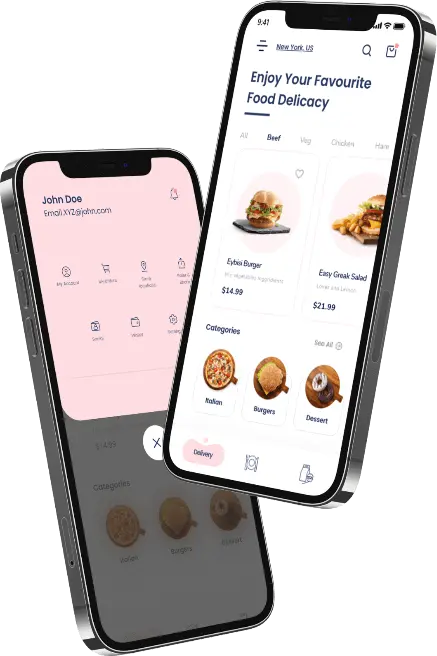4 Jan 2023
All You Need to Know About Mobile Payment Gateways in 2023
Surbhi Bhatia

One billion people will used in-store mobile payments by 2019. 61% of banks plan increased their mobile payment technology spending in 2018, a 52% increase over 2017.
These are only two examples of the thousands of statistical reports that go around whenever Mobile Payments are mentioned. These numbers are far from being a bubble. With the growing interest of Generation Z in technology, widespread adoption will be inevitable.
An app brand must be trendy, not only for this year but for the future, by either investing in the development of P2P payment apps or having introduced in-app payments.
This article is intended for anyone who wants to add a ‘Click To Pay’ option to their mobile apps. There are many ways your user could move within the mobile application, depending on the purpose of your app. This is a great place to start, as it will give you the information you need to talk to your mobile app development company about how to integrate the most popular technology.
We are now ready.
When users can pay from your app, this is how they will move within your app. In addition, this is how your payment gateway integration process will be affected by their movement.
What is a Mobile Payment Gateway?
A Mobile Payment Gateway allows users to authorize and process payments via mobile apps. It uses encryption and security protocols to protect transaction data. A gateway is a service that allows clients to connect with businesses in order to make financial transactions more convenient.
It takes just a few seconds to complete the entire process.
– Online buyers can add products or services to their shopping cart while browsing a mobile app.
– Then, they enter their payment information (e.g., credit card information) and are directed toward the payment gateway.
After the integrated payment gateway authenticates the request, the acquiring bank will receive it.
– Payment processors like MasterCard and VISA then verify the request.
– Once the digital payment has been approved, the acquiring banks send an authentication code to the online seller/merchant.
– The amount is debited from the buyer’s bank account.
How can your business benefit from Payment Gateway?
You can use a payment gateway to your website or mobile app to improve your product. A few key things will give you an edge over your competitors.
It is faster and easier to pay. You get a ready-made solution that starts with your authorization request and ends with the transaction.
Higher security and regulatory compliance. Payments by credit cards are subject to strict security requirements, such as PCI DSS. As a result, using a payment gateway automatically receives a better security system, fraud prevention, and compliance with all regulatory standards.
Supported transactions include different types. Different types of transactions are supported by different APIs. If you integrate this solution into your system, customers will be able to pay with more than a bank card. It’s convenient and very far-sighted.
Payment getaways offer fast and secure online payments, but they also allow for an advanced buying user experience through the possibility of storing payment information. This is an excellent benefit for any mobile or web app.
Types of Payment Systems
It is important to understand the types of payment systems or business models available before you decide on a payment gateway and method. In addition, you will learn about their functionality and differences.
– Hosted payment gateways. These gateways mean customers will be redirected from their website’s checkout page to the payment service provider page. Once the payment has been made, the customer is redirected to your website.
– PayPal is one of the most well-known examples. Hosted payment gateways can be quite convenient. The provider handles transactions and protects data. Merchants can customize the system to suit their needs.
– Self-hosted payment gateways. No third party is involved with payment service providers in self-hosted and non-hosted gateways. The eCommerce website owner collects all payment information. All payment details are then collected directly by the eCommerce website owner. These gateways often require customers to enter a secret code in order to complete the transaction. Shopify Payments is one example of a self-hosted payment gateway.
– API-hosted payment gateways. Customers can enter their payment information directly on the merchant’s checkout page. After that, the payment is processed via API or HTTP queries. This payment method is more user-friendly as customers are able to use it on their mobile devices. Stripe is an API-hosted gateway you have probably heard of.
– Direct payment gateway. This type is also known as local bank integration. It redirects customers from your site to the bank’s website, where they can complete the payment process. Customers will receive an email notification from the merchant once payment has been made.
– We can see that payment systems can be very different. The main differences are payment gateway integration, the involvement of third parties, and a primary approach for payment transactions.
What you should consider when entering the payment gateway integration process?
1. Type of account
There are two types of seller accounts: Dedicated and aggregate.
A Dedicated Account is a merchant account that is only for one merchant. This account is tailored to your specific business transaction needs.
Small businesses may find it difficult to set up dedicated accounts.
It allows you to create a personalized account type. However, it takes longer payment processing times and requires a thorough review of the business accounts before the account type can be created.
2. Type of product that you are selling – Material or Content
The type of product you sell through your app will determine the electronic money system you choose. You will still have the option to integrate with physical products. Selling digital merchandise can be a challenge.
App Store and Play Store prohibit the use of third-party e-commerce services when selling digital merchandise. Your app can only use platform-specific accounts (i.e. Apple or Gmail) to make transactions.
3. Security compliance
A PCI DSS compliance certificate is required to legally manage the user’s personal banking information. It is one of the seven essential requirements for integrating payment gateways in mobile apps. The certificate must be obtained even if you use a trusted payment gateway such as Stripe or PayPal. This is the process.
Prepare an information system that stores card data. This will ensure that you meet all requirements of PCI DSS.
Once the application system has been submitted, it will be reviewed by PCI Security Standard Council-authorized companies. Based on this, you will receive your certificate.
4. Dispute Management
It is also important to think about how you will deal with disputes that arise. For example, there are many situations where users may not receive their funds on time. In these cases, they might get another amount.
Although the merchant may claim that he has processed the refund, it might not reach the user. You need a dispute management system to manage these cases and many others.
Merchants associated with brands like FSS or ACI Worldwide can access dispute management systems from these companies. Your mobile app development company can set up a process even if you do not want to be associated with them. It will make it easier to get your PCI DSS certificate.
Now that you are familiar with the elements that must be considered during the development process of a Payment gateway-integrated app, we will walk you through the different payment gateways that brands use to simplify their payment process and make it universal.
They all offer similar charges plans, but we recommend you thoroughly research each one to help you make your decision.
A payment gateway’s advanced features and characteristics
1. Flexibility
When choosing the right gateway for an eCommerce site, flexibility is a key feature that both merchants and customers want.
You will require less tweaking if more options are available from your payment gateway.
You should also consider the cost and technical skills required to manage your digital enterprise.
2. Security
Buyers demand the highest level of data protection. High-security gateways are the winners of this race.
Payment processors use SSL to protect customer data.
Encrypted channels allow for the secure transmission of personal information over public channels.
3. Fees
Payment gateways charge a fee for every transaction on your eCommerce site.
The cost of your credit card may change depending on your location, what type of credit card you prefer, and many other factors.
4. Other charges
You may be charged additional fees for implementing a payment gateway.
These fees could include account management costs, withdrawal fees from the bank fees, and fees for setting up an account.
Businesses may find these fees a bit cumbersome, particularly if they are newer and trying to establish themselves in their industry.
Also Read – Technology Can Build a Recession-Proof Business: Here’s How!
5. Check availability in your country
You should verify that the preferred payment method is available in the countries where you and your clients reside.
If most customers are located in Asia, you will need to search for a payment provider that’s widely used and accepted in Asia.
Use These Popular Payment Gateways for Your Business
1. PayPal
PayPal is a well-known brand that handles online transactions.
It was founded more than 20 years ago. Since then, the Internet has aimed to facilitate the safe transfer of money to a growing audience.
PayPal is almost ubiquitous today. It is available to residents of more than 200 countries and all cards. A universal soldier.
PayPal can be used as a payment gateway to increase conversion rates by up to 40%
Pros
Each month or every year, there will be no additional costs.
– PCI-compliant.
Virtual Terminal allows electronic payments to be made by phone.
Cons
– Chargebacks may be higher than the average.
The account may be closed at any moment without notice. If the reactivation process takes more than 180 days, your funds will be frozen.
2. Square
Jack Dorsey and Jim McKelvey created the platform in 2009 to allow users to make payments using their mobile devices rather than costly POS infrastructure.
Square currently holds a 27.83% market share among POS systems.
Square provides contactless hardware to businesses of all sizes. It can be used with all major credit card brands, as well as Apple Pay and Google Pay.
It is currently only available in a few countries, including the United States of America and the United Kingdom of Great Britain, Northern Ireland, and several other regions of Europe.
Pros
– The POS software, as well as the magnetic stripe reader, are free of charge
– Compatible with small and medium enterprises
Additional support for businesses that don’t generate a lot of revenue.
The low-cost chip-card reader can be attached to any smart device to facilitate electronic payments.
– There is no monthly fee.
Supported currencies include more than 130.
Cons
Square is the only payment method that will be accepted.
Flat charges can be too expensive for companies.
PayPal is not supported.
3. 2checkout (Verifone)
2checkout, a payment processing company that assists up to 20,000 customers worldwide is called 2checkout.
It is compatible with most mobile devices. Additionally, it will accept payments from many credit cards, PayPal, and other PSPs.
The 2checkout commerce dashboard allows online merchants to review their client health, sales statistics, and marketing and merchandising abilities. In addition, the dashboard can be customized to your liking.
Pros
– Suitable for international and local distribution.
– There are no setup fees
Tier 1 security standards protect your online store and its customers from fraud.
– More than 120 shopping cart integrations are available, including the top sellers (Magento and Shopify), WooCommerce, and WooCommerce.
It can be used to market any product.
Cons
Online reviews indicate that the site’s support resources are inadequate.
2checkout is expensive and not recommended for new businesses.
4. Stripe
Stripe has been a major technological advancement and innovation player over the past ten years. This has been its primary source of competitive advantage.
The company simplifies the process of receiving payments and driving online activities for an organization. It makes it possible for any firm, whether a small startup or a large corporation.
Stripe offers more than 100 payment options. It is used in more than 40 countries by millions.
It is the top choice for E-commerce platform developers as it is easy to implement and manage.
Pros
– This platform offers a complete user interface toolkit that includes customizable checkouts, payment automation, wide API options, and many other high-end capabilities.
You will not be redirected to any third-party website during the payment processing phase.
– There is no setup fee.
There are approximately 450 modules and extensions.
Artificial intelligence is used to detect fraudulent activity and stop it from happening.
Cons
Unless you are a programmer, Stripe’s developer tools (API) and open-source application programming interface (API) won’t be of much use to you.
Stripe has fewer options than its counterparts for brick-and-mortar businesses.
Roadmap to Online Payment Gateway Integration
The above-mentioned payment gateways are certainly exceptional. What if you could create your application? This is certainly possible with the help of technology experts. Here’s how:
The time and method of integration with an online payment gateway depend on the scope of operations, the capabilities and limitations of the solutions being integrated, and the company’s IT infrastructure. Here are the steps we take to integrate with an online payment gateway.
Step 1.
Achieving success in integration implementation is possible only if you plan well. ScienceSoft’s team is responsible for this stage.
1. Analyzes the company’s requirements for online payment gateway integration. To gather requirements for an integrated solution, we interview key stakeholders.
- supported payment methods
- Geographic availability
- Customers’ shopping experience
- sensitive data security
- Transaction volume to be processed
- Transaction processing speed and more
2. Analyzes regulatory risks and compliance requirements
3. Identifies and resolves conflicts.
4. Defines the integration with an online payment gateway. Also, data to be shared (customers’ credit card data, personal information, address for crypto wallet, etc. ).
5. To understand the limitations and capabilities of the existing IT infrastructure and the software that will be integrated and analyzed.
6. These figures show how payment data should flow and whether it should be converted into another format.
7. Based on the requirements, it is possible to determine how many communication protocols will be used between integrated applications.
Step 2.
Here’s what is need to be taken care of during the following stage:
– Project deliverables.
– Budget and duration of the project.
– Key milestones, objectives, and KPIs are critical for the project.
– How to reduce risks
– Expected TCO, ROI, and cost savings for the integration solution
Step 3.
1. Deciding on the best type of online payment gateway to integrate with:
- A hosted payment gateway.
- A direct post-payment gateway.
- A white-label payment gateway that can be hosted on your server.
- A self-hosted custom payment gateway.
2. If required, designing architecture and a feature list for a custom online payments gateway
3. Assist clients in selecting the best market-available payment gateway according to their business priorities and specific criteria.
4. Designing the architecture for the integrated system and an integration solution (APIs, payment buttons, etc.). With attention to both functional and non-functional needs.
5. Optionally, designing a custom UI for a checkout page.
Step 4.
This stage includes:
– Definition of the technologies and tools needed to integrate an online payments gateway with appropriate corporate solutions and an outside payment processing system.
– Comparison of different tools and techs in the context of documented business needs
– The best integration tools and techs.
Step 5.
Important: Before implementing the integration, the company must:
- To receive customer payments, you can open a merchant account at a bank.
- You can open a merchant account through a payment processor (e.g., Stripe, Authorize.Net, PayPal).
The following steps are usually required for the implementation of an online payment portal integration solution:
1. If required, develop a custom payment gateway
2. Depending on the method chosen:
- Develop and install custom Integration APIs.
- Implementing ready-to-use APIs.
- Building payment buttonsand redirect scripts and integrating them into the checkout interface.
3. Functional, performance, and integration testing.
Step 6.
Optional: Support and evolution of the integrated system
Techugo provides continuous monitoring to its customers of the integrated system. This includes its vertical and horizontal scaling to process and store more significant transactions and expand a solution’s functionality according to a company’s changing business needs.
Drawing the Line
What are the requirements to integrate a payment gateway on your website? First, deciding what payment system you require and which provider offers the best terms for your business is essential. Thus, you can work with Techugo and let us handle the more difficult parts of the process.
So, what are you waiting for?
Get in touch.
Write Us
sales@techugo.comOr fill this form



 SA
SA  KW
KW  IE
IE AU
AU UAE
UAE UK
UK USA
USA  CA
CA DE
DE  QA
QA ZA
ZA  BH
BH NL
NL  MU
MU FR
FR 













